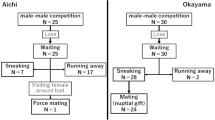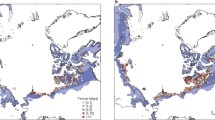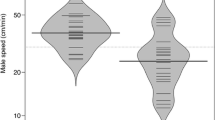Summary
In our study of ruff, a lekking shorebird, we found that the “lek ratio” — the proportion of the total population of males occurring on leks was low, averaging 12% over the breeding season (Fig. 1D). Off-lek males spent approximately the same proportion of time as lek males in displaying to females (Fig. 4). We defined three spacing tacties that male ruffs use to position themselves to court females: “Following” — directly pursuing females, and two types of lekking behavior, “Intercepting” — waiting for females at resource-rich sites, and “True Lekking” — waiting for females at places without any resources other than the males themselves. Males switched among these tactics, causing the lek ratio to vary over the season (Fig. 1 D). Lek ratio increased when the number of females present in the study area plummeted at the end of May, and was positively correlated throughout the season with the copulation rate of the preceding day, suggesting that males were tracking the behavior, as well as the number, of females available (Table 1, Fig. 1). Early in the season, males off leks spent most of their time feeding (Fig. 4), and lek ratio was positively correlated with temperature (Table 1), suggesting that some males may have been unable to lek during cold weather. Males on leks mated at significantly higher rates than Followers (Table 4). On average, males at our interception lek were less site faithful and less peristent than males at true leks, and the interception lek itself disappeared after females stopped coming to use its adjacent resource (Table 2, Fig. 5). The most successful individuals in our population were the True Lekking males, rather than the Interceptors.
In addition to the conditinal lekking tactics described here, ruff display a dimorphism in behaviorat leks. “Independent” males defend small courts on leks, while “Satellite” males share courts and mutually display with independents Both independents and satellites may use all three conditional tactics. We propose that satellites evolved as specialized. Followers, adept at tracking the movements of females among leks.
Similar content being viewed by others
References
Alcock J (1979) The evolution of intraspecific diversity in male reproductive strategies in some bees and wasps. In: Blum MS, Blum NA (eds) Sexual selection and reproductive competition in insects. Academic Press, New York, pp 381–402
Andersen FS (1951) Contributions to the biology of the ruff (Philomachus pugnax (L.)) III. Dansk Orn Foren Tidsskr 45:145–173
Austad SN (1984) A classification of alternative reproductive behaviors and methods for field-testing ESS models. Am Zool 24:309–319
Bancke P, Meesenburg H (1958) A study of the display of the ruff (Philomachus pugnax) (L.) II. Dansk Orn Foren Tidsskr 52:118–141
Bradburg J (1977) Lek mating behavior in the hammerhead bat. Z Tierpsychol 45:225–255
Bradbury J, Gibson R, Tsai IM (1987) Hotspots and the dispersion of leks. Anim Behav (in press)
Cramp S, Simmons KEL (eds) (1983) The birds of the western palearctic, vol 3. Oxford University Press, New York, pp 385–402
Davies NB (1982) Behaviour and comptition for scarce resources. In: The King's College Sociobiology Group (eds) Current problems in sociobiology. Cambridge University Press, Cambridge, pp 363–380
Dawkins R (1980) Good strategy or evolutionarily stable strategy? In: Barlow GW, Silverberg J (eds) Sociobiology: beyond nature/nurture? Westview, Boulder, pp 231–249
Dominey WJ (1984) Alternative mating tactics and evolutionarily stable strategies. Am Zool 24:385–396
Dunbar RIM (1982) Intraspecific variations in mating strategy. In: Bateson PG, Klopfer PH (eds) Perspectives in ethology, vol 5. Plenum Press, New York, pp 385–431
Emlen ST, Oring LW (1977) Ecology, sexual selection, and the evolution of mating systems. Science 97:215–223
Emmons SR, Braun CE (1984) Lek attendance of male sage grouse. J Wildl Manage 48:1023–1028
Greenhalgh ME (1968) The sex ratio of migrant ruffs. Bird Study 15:210–212
Harengerd M (1982) Beziehungen zwischen Zug und Mauser beim Kampfläufer,Philomachus pugnax (Linné 1758, Aves, Charadriiformes, Charadriidae). PhD dissertation, Friedrich-Wilhelms-Universität, Bonn
Hogan-Warburg AJ (1966) Social behavior of the ruff,Philomachus pugnax (L.). Ardea 54:109–229
Pearson DJ (1981) The wintering and moult of ruffs,Philomachus pugnax, in the Kenyan rift valley. Ibis 123:158–182
Rhijn JG van (1973) Behavioural dimorphism in male ruffs,Philomachus pugnax (L.). Behaviour 47:153–229
Rhijn JG van (1983) On the maintenance of alternative strategies in the ruffPhilomachus pugnax. Ibis 125:482–498
Ripon AB, Boag DA (1974) Recritment to populations of male sharp-tailed grouse. J Wildl Manage 38:616–621
Selous E (1907) Observations tending to throw light on the question of sexual selection in birds, including a day-to-day diary on the breeding habits of the ruff (Machetes pugnax). Zoologist 11:367–381
Shepard JM (1976) Factors influencing female choice in the lek mating system of the ruff. Living Bird 14:87–111
Siira J (1970) Studies in the ecology of the sea-shore meadows of the Bothnian Bay with special reference to the Liminka area. Aquilo Ser Bot 9:1–109
Vos GJ de (1983) Social behavior of black grouse: an observational and experimental field study. Ardea 71:1–103
Author information
Authors and Affiliations
Rights and permissions
About this article
Cite this article
Lank, D.B., Smith, C.M. Conditional lekking in ruff (Philomachus pugnax). Behav Ecol Sociobiol 20, 137–145 (1987). https://doi.org/10.1007/BF00572636
Received:
Accepted:
Issue Date:
DOI: https://doi.org/10.1007/BF00572636




